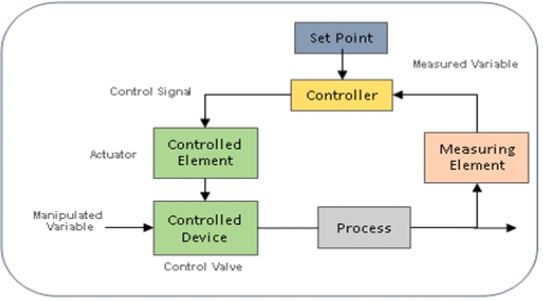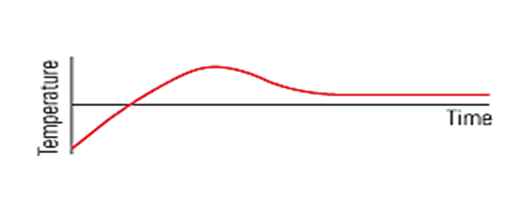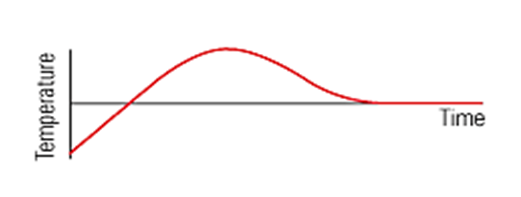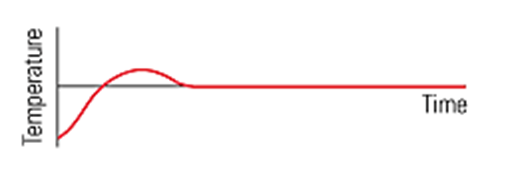In Industry, precise control of process temperature plays a crucial role in achieving final product quality
and sustaining productivity.
The methods most commonly used are :
- Manual Temperature Control
- Automatic Temperature Control
• On-off temperature control
• PID temperature control
Any control system performs four essential functions - measurement, comparison, computation and
correction.
In a manual temperature control system all these functions need to be performed by the
operator.
However, manual operation is prone to human error.
Lapses in accuracy and continuity can
affect the overall efficiency of the process.
What is an automatic temperature control system?
In automatic temperature control systems, the four essential functions of the system,
i.e. measurement,comparison, computation and correction are done with help of sensors,
controllers and control valve with actuator and positioner .
Typical temperature control loop

In a typical temperature control loop, the sensor sends a signal to the controller. Based on this signal, the controller, which may take signals from more than one sensor, determines whether a change is required in the manipulated variable. It then commands the actuator to change the position of the valve to either open more or close more - depending on the requirement.
Why automatic temperature control?
As explained above, manual operation can result in reduced overall efficiency of the temperature control system.
On/off temperature control: On/off control will always lead to temperature overshoot and higher fuel consumption; thereby higher utility cost.
Typical On-Off temperature control loop
In this type of a control system, the solenoid valve performs the key function of regulating the supply to the actuator. The air supply is either 100% ON or 100% OFF.
Application for On-Off temperature control
|
Applications
|
On/Off
|
|
Fast response/ quick opening required
|
?
|
|
Constant heat load
|
?
|
PID temperature control: PID control is the most accurate control wherein the exact set process value (set temperature) is achieved, as opposed to on/off control where temperature fluctuation within a band occurs.
In this type of a control system, the positioner mounted on the control valve performs the key function of regulating the air supply to the actuator. The air supply is modulated as the per the current signal received from the PID controller. An inbuilt E/P converter ensures modulated air supply to the actuator.
Applications for PID temperature control
|
Applications
|
PID
|
|
Where accurate temperature control is essential; overshoot is not
tolerable
|
?
|
|
Variable set temperature
|
?
|
|
Variable heat load
|
?
|
|
When product quality is dependent on temperature accuracy
|
?
|
|
When safety of operation is temperature sensitive
|
?
|
Proportional Control
This is a most basic continuous control mode. This controls the opening & closing of control valve
depending upon process requirement.But, this control will always come with an error/offset, because
this logic acts only when it senses the deviation.
Integral Action
The function of the “I” action is to eliminate the offset (sustained deviation) by continuously moving the
proportional band up and down as necessary (by altering the set point)
Integral action is also known as automatic reset.
Derivative Action
With a P+I control system, overshoot is likely to occur on start up.
Derivative action provides extra push for quick return to set value. Hence low overshoot during start up.
Thus, PID based automatic temperature control system improves.
Energy Efficiency
- No steam wastage due to better control of process temperature.
- Reduced fuel consumption, thereby reduced operating cost.
Product Quality
- Accurate temperature control within desired limits ensures optimum product quality and reduction in rejections / rework for temperature sensitive processes.
- Enables consistency in production and product quality.
- Leads to savings in raw material cost involved.
Operational Safety
- Ensures safety and there by eliminates risk during processing.
- Overheating/ cooling due to inaccurate temperature control may lead to unwarranted / dangerous process conditions, this situation can be eliminated / controlled.
| Control Mode |
Typical System Responses |
Advantages/Disadvantages |
| On/Off |
 |
•Inexpensive
• Simple
• Operating differential can be outisde of process requirements
|
| Propotional (P) |
 |
•Simple and stable
• Easy to set up
• Fairly high initial deviation(unless a large P band is chosen), then sustained offset
• Offset occurs
|
| Propotional plus Integral (P+I) |
 |
• No sustained offset
•Increase in propotional band usually required to overcome instability
• Possible increased overshoot
|
| Control Mode |
Typical System Responses |
Advantages/Disadvantages |
| On/Off |
 |
•Stable
• Rapid response to chnages
• Some offset
|
| Propotional plus Integral (P+I) |
 |
• Will give best control,no offset & minimal overshoot
•More complex to set up manually but most electronic controllers have an 'auto tune' facility
• More expensive where pneumatic controllers are concerned
|